Introduction & Navigation
You have the ability to have multiple applicant records open at any one time and can return to the Applicant Record hub using the Hub icon in the top left.

At the top of each applicant record is the applicant name banner which will display their name (including a known as if one has been entered), their current job title (if entered in the employment tab), their status (if entered in the overview > details tab) and the highest (live) submission stage. The colour the name banner information is displayed in is related to the colour assigned to the status (e.g. Currently Looking, Available etc. see the article Data | List Items).

The applicant’s name can be edited, and/or a known as entered by clicking on the applicant’s name.
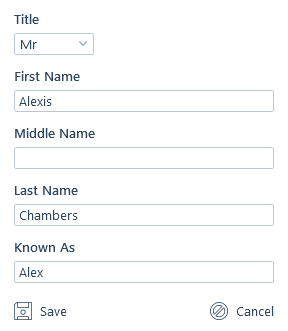
In the top right of each record, you will find: links to the applicant’s social media accounts; functions to mark the applicant as a favourite; record Refresh; the applicant’s record ID number (which can be copied to your clipboard by hovering to the right of the number) and who and when the record was created. Additionally, if you have permission to you can archive or delete the record.

Each record type in itris has an action bar with actions relevant to the record type. On the Applicant record, this includes creating new appointments and comments, sending emails, sending SMS’, actions relating to the submissions process and creating the applicant as a contact. Please see the following articles for further information: New Appointments, Comments, Quick Comments, New Email Form, Using SMS, Submissions Area, CV Marketing Hub, Quick Placements, New Placement, Linking Applicant & Contact, Appointments Report, Posting to Integrations and Record Sharing.

Overview
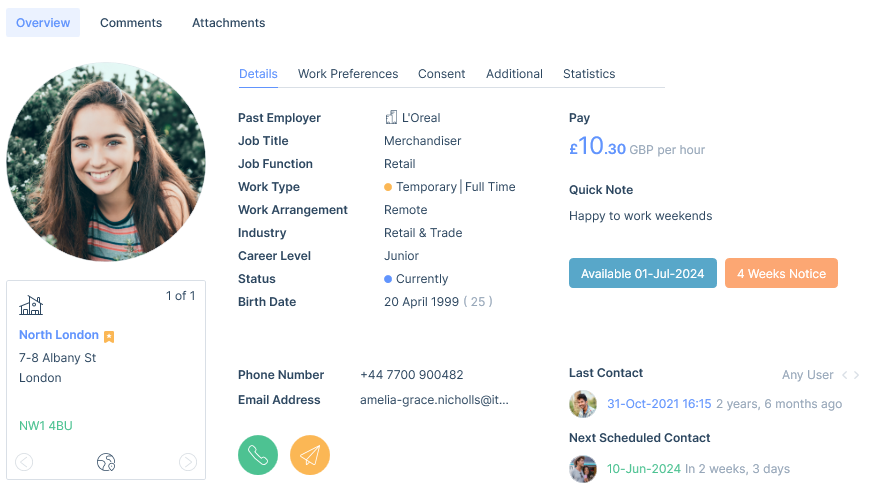
In the overview area, you are able to add a picture of the applicant. If a picture is added, it will be displayed in the circle and appear under the attachments, if no picture is added the circle will display with a colour related to their status and the applicant’s initials.
As Pictures are attachments against the record they may have Data Access Groups (DAGs) applied to them. DAGs restrict users view and manage access to attachments. Please see the Attachments article for further information.
Below the picture, their address(es) will be displayed, with the ability to view them via google maps.
Details
Much of the information in the details area is linked to other parts of the applicant record. For example, Employer, Job Title, Job Function, Work Type, Work Arrangement, Industry, Career level and Pay are all taken from the applicant’s most recent employment, listed within the Employment area (see the Employment article).
The applicant status can be updated by clicking on the status field name itself. An applicant status is effectively a way of recording the circumstance of the applicant in a quick summary way, which is also visible on the applicant record card, and it can be searched on. See the article for Record Cards. A colour is associated with each status and will impact how the name banner is displayed. See the article Data | List Items.
The quick note is often used to display a short, but important/relevant note about the applicant that is useful or important to know, this is also a searchable field. If you have permissions to you are able to the quick note as a warning which will mark it as red on the record, you can find out more about permissions in the article User Management | Permissions.

The details area will also display information about the applicant’s availability. itris gives you the flexibility of being able to add both an available date and/or a notice period.

In addition to being able to manually update the availability, upon saving a new placement, the applicant’s Availability and Notice Period is updated as follows:
Permanent Placements:
- Notice Period: Set to that of the new placement. Any existing value is removed if no notice period is set on the placement.
- Availability: Remove any existing value.
Temp / Contract Placements:
- Notice Period: Set to that of the placement. Any existing value removed if no notice period is set on the placement.
- Availability: Set to the day after the end date of the placement.
With the exception of extensions made to Temp and Contract placements any other manual edits after the initial placement is made will not update the availability on the applicant record.
Under Communication, the applicant’s default telephone number and email address will be displayed. These items and the icons below are quick links, for example, clicking on the email address or email icon will open the email form (see the Communication Assignment article). You can also copy them to your clipboard by hovering to the right of the entry.

You will also find the applicant’s birth date here, and you can choose whether or not the year of birth shows in the itris Management Utility, see the Settings | General Settings article. Recording at the very least the birth date will result in applicants showing within the Active Business Intelligence dashboard, Applicant Birthdays area where applicable, providing the opportunity to improve rapport and potentially differentiate your businesses customer service. See the Dashboard | Active Business Intelligence article.
This area also displays the Last Contacted Date, where you can switch between the last date you contacted the applicant, or any user contacted the applicant. This gives you a quick view of communication activity against the applicant record. Please refer to the Data | List Items article on how to set comments to update last contacted date.
The Next Scheduled Contact date is determined by the date and time of the first appointment where the applicant is an attendee, and the appointment starts today or in the future. Appointments with the type of “General” are not included. When the “Just Mine” filter is applied, only appointments where you (the current user) are an attendee are displayed.
From here you have the ability to edit, cancel or complete the appointment, by hovering over the Next Scheduled Contact and clicking the view icon the Appointment Card will appear.

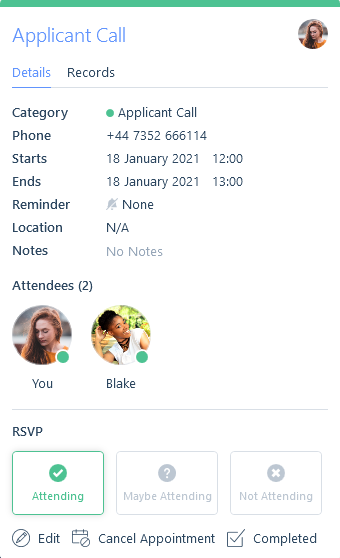
Work Preferences
Whereas the details and employment areas show what the applicant is/has been doing, the Work Preferences reflect what they want in the future. This area records the details of the type of role, salary, work capacity/type/arrangement the applicant desires and the locations they are willing to work in.

The Job Title field will allow you to select from the list item (see the Data | List Items article) or free text to indicate their desired role.
Job function is a list item (see the Data | List Items article) and acts as a level above Job Titles. This list can be used however your organisation decides, an example of how this may be used is where you can categorise jobs such as Brand Journalist, Blogger, Column Journalist, Photo Editor etc. under the job function Journalism. Job Function is searchable and gives you the ability to search for a list of applicants that are currently working within or keen on a particular Job Function.
Locations and Industries allow you to list places and industries the applicants; ideally want to work in, are prepared to work in or not prepared to work in. These are both searchable fields and allow you to specify areas that may be of interest to the applicant beyond their current experience or location. Just because an applicant has previously worked in the Medical industry in London does not mean they wish to continue doing so. Please see the following articles for further information: Location Assignment and Industries
Consent
The Consent tab is where you can set the applicant’s Retention and Marketing Preferences.
It is worth noting that if an applicant has opted out of a particular marketing preference, for example, email, this will prevent the applicant receiving mailshots. This will not stop you sending communications via that route on an individual basis, e.g. a direct email just to the applicant.
For more information on Consent, please see the article Retention Consent & Marketing Preferences.
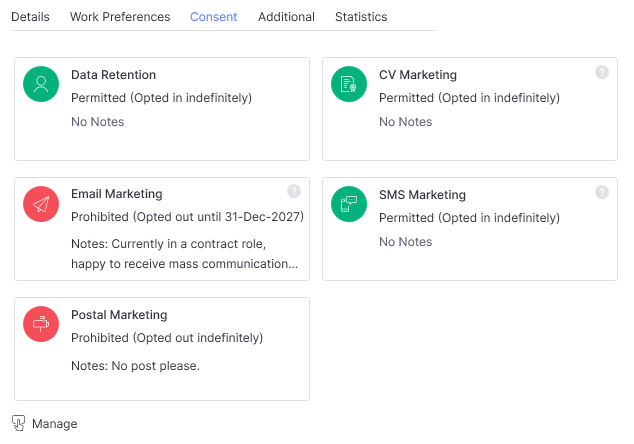
Additional

Further information about the applicant, including Nationality and Professional Start Date/Years (PQE) is shown under the Additional tab.
A default Employment Type can also be selected here which will be applied when the applicant is placed into an interval charge placement, though can be changed on the placement if required.
Statistics
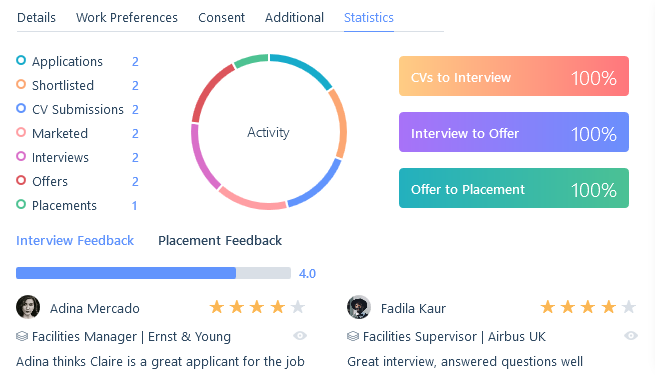
The Applicant statistics tab gives a snapshot of recruitment activity against the individual record, including feedback on any interviews and placements, providing you an overview and visual representation of the applicant’s performance within the recruitment process for your company. Please see the Statistics | Applicant & Contact article for further information.
Information area
In the bottom left of the overview tab is the information area, where you can add further data to the record. Each tab in the information area has a separate article covering its functionality. Please see the following articles: Keyword Assignment, Custom Field Assignment, Addresses, Communication Assignment, Assignees, Record Groups, Sources Assignment, Restrictions, Relationships, Summary.
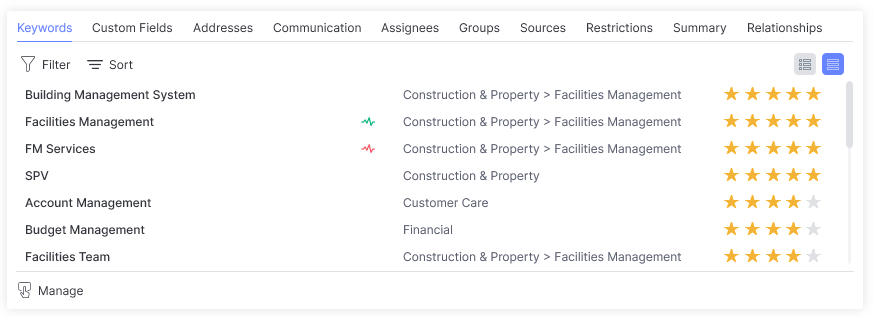
CVs, Employment & References
In the top right of the overview tab, you will find plain text versions of the most recent Original & Formatted CVs added to the record (you will also find these under attachments). From here you can add new versions (via the New button or by dragging and dropping a CV from file onto the Original & Formatted tabs), open the current version (view), delete or edit.
CVs are essentially attachments and therefore may have Data Access Groups (DAGs) applied to them. DAGs restrict users view and manage access to attachments. Please see the CVs | Original & Formatted and Attachment articles for further information.
Under the employment tab, you can detail all the places the applicant has worked, is currently working or will be working in the future. These placements can include those made by your company as well as external placements. The latest employment details entered will be reflected in the information displayed in the record’s details area.
References can also be managed via this area.
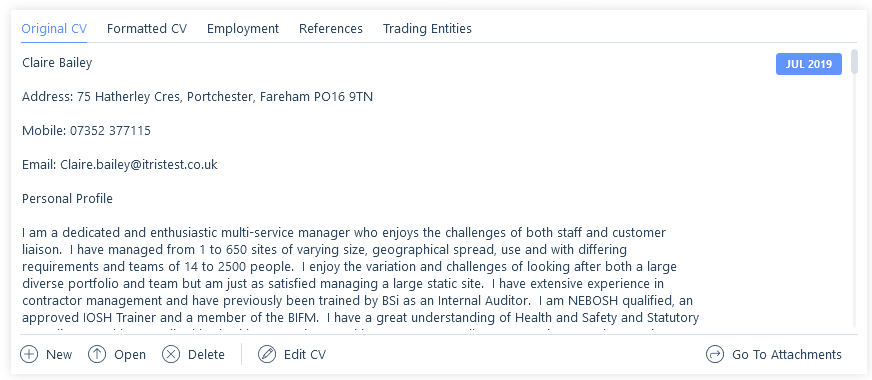
Each tab in this area has a separate article covering its functionality. Please see the following articles: CVs | Original & Formatted, Employment, References, Trading Entities.
Submissions area
The submissions area tracks and manages all stages of an applicant’s submissions from application through to being placed. Additionally, it will also track when the applicant is marketed to a contact.
This area is essentially a mechanism that allows you to put an applicant in at any level, and move them through the submission levels based on their successes.

Please see the articles CV Marketing Hub and Submissions Area for further information.
Comments
Comments are a useful tool for tracking communications with an applicant, and recording comments allows for the smooth flow of information and transparency. Depending on your company settings, in addition to comments you manually add, you may find emails sent to and received from the applicant display here (with the email additionally visible via the attachments area). Please see the Comments article for further information.

Attachments
Attachments are an integral part of any database software, particularly in recruitment as applicant CVs are generally essential to the workflow. Attachments are also important for several parts of the system, such as compliance, references, contracts, etc. Please see the Attachments article for further information.

Applicant Compliance
Applicant compliance is determined by Global only or both Global and Job Function Auto-Generated Compliance. Where Job Function compliance is used, this will reference the Job Function set on the applicants Work Preferences tab. Learn more about this area and how to manage compliance items from it in the article Compliance | Applicant Compliance.
